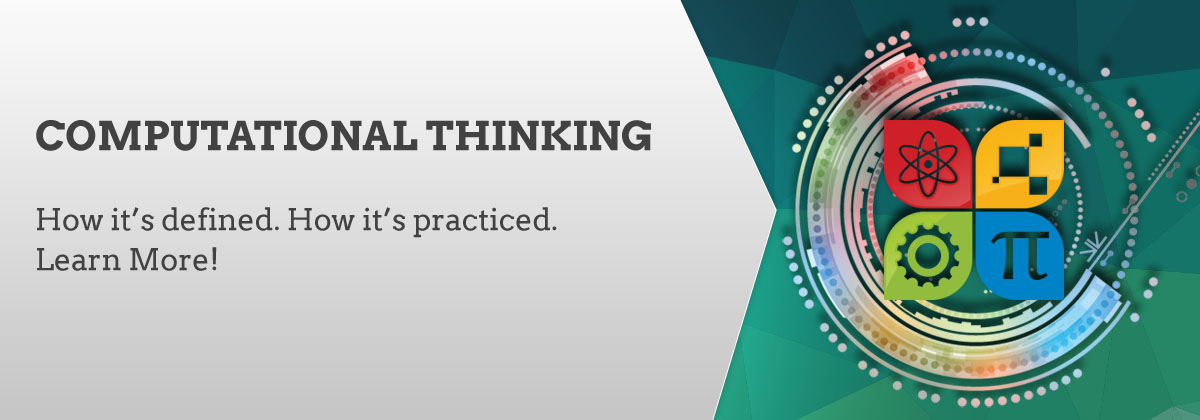Computational Thinking

In education, computational thinking is a set of problem-solving methods that involve expressing problems and their solutions in ways that a computer could execute.
“Our field has long been confused about educational technologies. National surveys consistently show that Americans think first of computers when asked to define technology. The development of technological literacy standards indicated that computers are but one tool in the use of technologies, rather than its sole definition or purpose. Computer programming was once more closely associated with a career and technical education path than with the technological literacy of open-ended engineering design and problem solving. With the greater capabilities and infusion of computational thinking in today’s work world, perhaps it is time for educational leaders to begin rethinking long-held ideas about computational thinking” (Buckler, Koperski, & Loveland, 2017).
ITEEA is providing this fundamental resource to lead our profession and enable all technology and engineering educators, along with their STEM colleagues from other disciplines, to take the initiative and better understand how computational thinking is operationally defined within the context of teaching through a technology and engineering education and Integrative STEM Education approach. The eventual goal is to operationalize “I-STEM” to provide examples that assist technology and engineering educators (and all others in the STEM field) to understand and implement computational thinking and understandings that are driven through engagement and dynamic instructional practices preK-12 and beyond to benefit ALL students!
This resource provides a launching point upon which teachers can build in their technology and engineering classrooms. The intent is to identify promising computational thinking practices as part of instructional practices and demonstrate to the entire STEM community the value of quality technology and engineering education that classroom teachers provide to students each and every day.
References:
Buckler, C., Koperski, K., & Loveland, T. (2017). Is computer science compatible with technological literacy? Technology and Engineering Teacher, 77(4), pp 15-20.
Jeannette Wing in 2006 published the seminal call to arms Computational Thinking Viewpoint in the March issue of Communications. Wing argued then that computational methods, concepts and tools could be embedded in all K-12 classrooms to develop computation skills and literacy in all students. Recent writing by Wing and Stanzionne (2016) focused on the potential of computational thinking to be a third pillar of the scientific method, its use in simulation of complex systems and use by academic and STEM educators as a fundamental tool of education.
Computational thinking is the “thought processes involved in formulating problems and their solutions so that the solutions are represented in a form that can be effectively carried out by an information processing agent” (Czerkawski & Lyman, 2010). It involves the use of logic, algorithmic thinking, recursive thinking, abstraction, parallel thinking, pattern-matching and other related processes. The College Board (2016) identifies seven big ideas related to computer science: Creativity, Abstraction, Data and Information, Algorithms, Programming, The Internet, and Global Impact.
How is computational thinking related to I-STEM Education? Should use of computers dominate our discussions and work in technology and engineering? Is computational thinking compatible with technological literacy? These questions continue to be raised by educators in our field as efforts are underway to promote computational thinking as our new focus and an equally determined group of educators wanting to keep computers as subservient to the greater goals of technological literacy. It is clear that to include technological literacy in computer science coursework at the K-12 level would be a lot harder to implement than including computational thinking in Technology and Engineering coursework.
In these tabs, ITEEA will provide best practice examples on how to include computational thinking in your program, courses and lesson plans in a way that promotes technological literacy, and the hands-on, mind-on practices we are known for.
References:
Czerkawski, B., & Lyman, E. (2015). Exploring issues about computational thinking in higher education. Techtrends: Linking Research & Practice to Improve Learning, 59(2), 57-65.
The College Board (2016) AP computer science principles: Course and exam descriptions. Princeton, NJ: Author.
Wing, J., & Stanzione, D. (2016). Progress in computational thinking, and expanding the HPC community. Communications of the ACM, 59(7), 10-11.
- Data Collection and Visualization via $16 MicroBit
- Crumble Student Packet
- The Crumble: Integrating Computer Science through Engineering Design
- Promoting Mind and Body Fitness by Engaging Students in Active Game Design
- The Orange Pi: Integrating Programming Through Electronic Technology
- Integrating Computational Thinking through Wearable Technologies and Programmable e-Textiles
- OmmTech - A Middle School Start-Up
- Best YouTube Channels to Learn Coding
- Computer Science Teachers Association (CSTA)
- Computational Thinking Presentation
- Computational Thinking: What is it? How Should it be Taught?
- The Computer Science and Computational Thinking of STEM
- Computer Science and Technology and Engineering Education: A Content Analysis of Standards and Curricular Resources
- Computational Thinking Framework Alignment
- CSTA K-12 Computer Science Standards
- Is Computer Science Compatible with Technological Literacy?
- Integrating Computational Thinking into Technology and Engineering Education
- Internet Terms Defined
- On Computational Thinking and STEM Education | Journal for STEM Educ Res 3, 147-166 (2020)
"Physical Computing" Connects Computer Science with Hands-On Learning | Education Week - Recommendations to Support Computational Thinking in the Elementary Classroom
- Standards for Technological Literacy: Content for the Study of Technology
